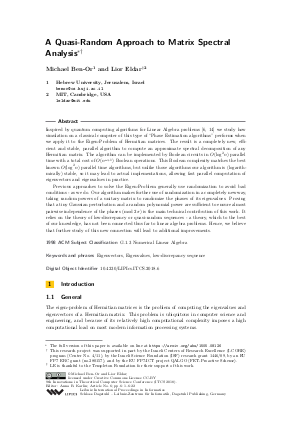A Quasi-Random Approach to Matrix Spectral Analysis
Authors Michael Ben-Or, Lior Eldar
-
Part of:
Volume:
9th Innovations in Theoretical Computer Science Conference (ITCS 2018)
Part of: Series: Leibniz International Proceedings in Informatics (LIPIcs)
Part of: Conference: Innovations in Theoretical Computer Science Conference (ITCS) - License:
 Creative Commons Attribution 3.0 Unported license
Creative Commons Attribution 3.0 Unported license
- Publication Date: 2018-01-12
File

PDF
LIPIcs.ITCS.2018.6.pdf
- Filesize: 0.58 MB
- 22 pages
Document Identifiers
Subject Classification
Keywords
- linear algebra
- eigenvalues
- eigenvectors
- low-discrepancy sequence
Metrics
- Access Statistics
-
Total Accesses (updated on a weekly basis)
0PDF Downloads0Metadata Views
Abstract
Inspired by quantum computing algorithms for Linear Algebra problems [Harrow et al., Phys. Rev. Lett. 2009, Ta-Shma, STOC 2013] we study how simulation on a classical computer of this type of "Phase Estimation algorithms" performs when we apply it to the Eigen-Problem of Hermitian matrices. The result is a completely new, efficient and stable, parallel algorithm to compute an approximate spectral decomposition of any Hermitian matrix. The algorithm can be implemented by Boolean circuits in O(log^2(n)) parallel time with a total cost of O(n^(\omega+1)) Boolean operations. This Boolean complexity matches the best known O(log^2(n)) parallel time algorithms, but unlike those algorithms our algorithm is (logarithmically) stable, so it may lead to actual implementations, allowing fast parallel computation of eigenvectors and eigenvalues in practice. Previous approaches to solve the Eigen-Problem generally use randomization to avoid bad conditions - as we do. Our algorithm makes further use of randomization in a completely new way, taking random powers of a unitary matrix to randomize the phases of its eigenvalues. Proving that a tiny Gaussian perturbation and a random polynomial power are sufficient to ensure almost pairwise independence of the phases (mod 2pi) is the main technical contribution of this work. It relies on the theory of low-discrepancy or quasi-random sequences - a theory, which to the best of our knowledge, has not been connected thus far to linear algebra problems. Hence, we believe that further study of this new connection will lead to additional improvements.
Cite As Get BibTex
Michael Ben-Or and Lior Eldar. A Quasi-Random Approach to Matrix Spectral Analysis. In 9th Innovations in Theoretical Computer Science Conference (ITCS 2018). Leibniz International Proceedings in Informatics (LIPIcs), Volume 94, pp. 6:1-6:22, Schloss Dagstuhl – Leibniz-Zentrum für Informatik (2018)
https://doi.org/10.4230/LIPIcs.ITCS.2018.6
BibTex
@InProceedings{benor_et_al:LIPIcs.ITCS.2018.6,
author = {Ben-Or, Michael and Eldar, Lior},
title = {{A Quasi-Random Approach to Matrix Spectral Analysis}},
booktitle = {9th Innovations in Theoretical Computer Science Conference (ITCS 2018)},
pages = {6:1--6:22},
series = {Leibniz International Proceedings in Informatics (LIPIcs)},
ISBN = {978-3-95977-060-6},
ISSN = {1868-8969},
year = {2018},
volume = {94},
editor = {Karlin, Anna R.},
publisher = {Schloss Dagstuhl -- Leibniz-Zentrum f{\"u}r Informatik},
address = {Dagstuhl, Germany},
URL = {https://drops.dagstuhl.de/entities/document/10.4230/LIPIcs.ITCS.2018.6},
URN = {urn:nbn:de:0030-drops-83288},
doi = {10.4230/LIPIcs.ITCS.2018.6},
annote = {Keywords: linear algebra, eigenvalues, eigenvectors, low-discrepancy sequence}
}
Author Details
References
-
Selim G. Akl. Parallel Sorting Algorithms. Academic Press, Inc., Orlando, FL, USA, 1990.

- F. L. Bauer and C. T. Fike. Norms and exclusion theorems. Numerische Mathematik, 2(1):137-141, Dec 1960. URL: http://dx.doi.org/10.1007/BF01386217.
- Dario Bini and Victor Y. Pan. Practical improvement of the divide-and-conquer eigenvalue algorithms. Computing, 48(1):109-123, 1992. URL: http://dx.doi.org/10.1007/BF02241709.
- James Demmel, Ioana Dumitriu, and Olga Holtz. Fast linear algebra is stable. Numerische Mathematik, 108(1):59-91, 2007. URL: http://dx.doi.org/10.1007/s00211-007-0114-x.
-
Gene H. Golub and Charles F. Van Loan. Matrix Computations (3rd Ed.). Johns Hopkins University Press, Baltimore, MD, USA, 1996.

- Aram W. Harrow, Avinatan Hassidim, and Seth Lloyd. Quantum algorithm for linear systems of equations. Phys. Rev. Lett., 103:150502, Oct 2009. URL: http://dx.doi.org/10.1103/PhysRevLett.103.150502.
-
Dexter C. Kozen. The Design and Analysis of Algorithms. Springer-Verlag New York, Inc., New York, NY, USA, 1992.

- Mauro Leoncini, Giovanni Manzini, and Luciano Margara. Parallel complexity of numerically accurate linear system solvers. SIAM J. Comput., 28(6):2030-2058, 1999. URL: http://dx.doi.org/10.1137/S0097539797327118.
- Hoi Nguyen, Terence Tao, and Van Vu. Random matrices: tail bounds for gaps between eigenvalues. Probability Theory and Related Fields, pages 1-40, 2016. URL: http://dx.doi.org/10.1007/s00440-016-0693-5.
- H. Niederreiter. Random Number Generation and Quasi-Monte Carlo Methods. Society for Industrial and Applied Mathematics, 1992. URL: http://dx.doi.org/10.1137/1.9781611970081.
-
John H. Reif. Efficient parallel factorization and solution of structured and unstructured linear systems. Journal of Computer and System Sciences, 71(1):86-143, 2005.

-
Gilbert W. Stewart and Jiguang Sun. Matrix perturbation theory. Computer science and scientific computing. Academic Press, Boston, 1990.

-
G.W. Stewart. Pertubation bounds for the definite generalized eigenvalue problem. Linear Algebra and its Applications, 23:69-85, 1979.

- Amnon Ta-Shma. Inverting well conditioned matrices in quantum logspace. In Dan Boneh, Tim Roughgarden, and Joan Feigenbaum, editors, Symposium on Theory of Computing Conference, STOC'13, Palo Alto, CA, USA, June 1-4, 2013, pages 881-890. ACM, 2013. URL: http://dx.doi.org/10.1145/2488608.2488720.
-
Lloyd N. Trefethen and David Bau. Numerical linear algebra. Society for Industrial and Applied Mathematics, Philadelphia, 1997.

- Virginia Vassilevska Williams. Multiplying matrices faster than coppersmith-winograd. In Howard J. Karloff and Toniann Pitassi, editors, Proceedings of the 44th Symposium on Theory of Computing Conference, STOC 2012, New York, NY, USA, May 19 - 22, 2012, pages 887-898. ACM, 2012. URL: http://dx.doi.org/10.1145/2213977.2214056.
